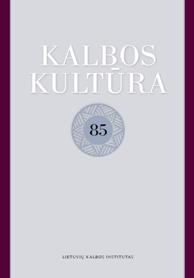Vedinių pateikimo sistemiškumas Bendrinės lietuvių kalbos žodyne
The systematicity of the presentation of derivates in Bendrinės lietuvių kalbos žodynas (Dictionary of Standard Lithuanian)
Author(s): Daiva MurmulaitytėSubject(s): Baltic Languages
Published by: Lietuvių Kalbos Institutas
Keywords: derivate; defining dictionary; sistematicity; underlying word;dictionary entry;
Summary/Abstract: The Lithuanian language institute is using new methods in preparation of Bendrinės lietuvių kalbos žodynas (Dictionary of Standard Lithuanian) the concept of which emphasizes the principle of systematicity – one of the main requirements of a quality dictionary. This article discusses how successful the attempts to apply this principle have been when presenting derivates in this dictionary and what difficulties have been faced. Different derivates are researched: verbal and nominal abstracts, diminutives, derivates with the negative prefix ne- and reflexive verbs. The comparison with other dictionaries of the Lithuanian language (Dabartinės lietuvių kalbos žodynas (Dictionary of Contemporary Lithuanian), academic Lietuvių kalbos žodynas (Dictionary of the Lithuanian Language), etc.) and explanatory dictionaries of the other languages (Latvian, Russian, Polish, English) is made andthe main principles and methodology of the presentation of derivates in Bendrinės lietuvių kalbos žodynas are introduced.The main principle is that derivates (except for verbs with the prefix ne- and the majority of reflexive verbs) are presented not in the entries of underlying words, but as separate entries. In such entries the presentation of abstract nouns (for instance miauktelėjimas, priglaudimas, paskiepijimas, broliavimasis, audringumas, aukštybė, brangybė, brolystė), diminutives (for instance auselė, balandėlis, namukas) and words except for verbs with a negative prefix (for instance nedarna, nedaugelis, nedidelis, neblogas, neblogai, neginčijamai) is analogous with the presentation of other lexical units. Different meanings are separated according to their usage,each lexeme has appropriate grammatical, lexical, stylistic, usage field and other marks and illustrative examples of usage which reveal the semantic and syntactic valency are presented. Transpositional derivates and abstracts (names of qualities or actions) are presented with their underlying nomen or verb and the number corresponding to one of the meanings. Lexicalized abstracts are defined or (and) explained through synonyms.The non-formal presentation of abstract nouns raised a number of problems which were probably not encountered when preparing dictionaries with a different structure. For instance, grammars suggest that abstract nouns are usually used in singular, though not every lexeme of an abstract noun presented in a separate entry can be marked as vns. (sing.) – quite a lot depends on the semantics of a particular verb. This aspect of abstract noun presentation is still being discussed.There are two ways of presenting words with the prefix ne- in Bendrinės lietuvių kalbos žodynas. Nouns, adjectives and adverbs are presented in separate entries and verbs – in the entries of the corresponding underlying verbs as their illustrative examples. The consistent application of the principle of systematicity and the presentation of such verbs analogically to the presentation of other parts of speech which have a negative prefix would enlarge the volume of the dictionary substantially and extend the term of preparation. It would take even longer if at the final stage twofold presentation (incorporated and separate) of reflexive verbs was changed. Thus in the meantime an exception is made for these two groups with the hope to return to this issue and to search for alternative solutions in future editions.
Journal: Bendrinė kalba (iki 2014 metų – Kalbos kultūra)
- Issue Year: 2012
- Issue No: 85
- Page Range: 71-91
- Page Count: 21
- Language: Lithuanian

